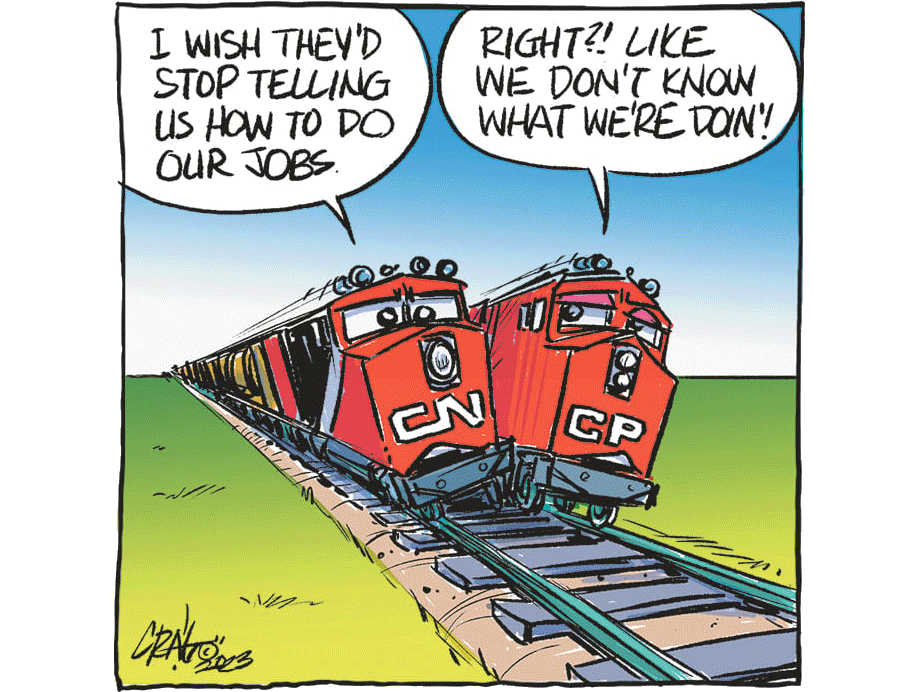

Canada - Neither the railways nor grain shippers are happy with the federal proposal to temporarily
expand the availability of regulated interswitching between Canada's two national railways, but for different
reasons.
The Railway Association of Canada says extending the statutory zone in which a carrier must pick up a shipper's cars
and deliver them to a competing carrier, to 160 kilometres from 30, will increase costs and inefficiencies by slowing
grain movement by as much as 25 percent.
It says the added layer of regulation will damage Canada's competitiveness, disrupt supply chains, add to inflation,
and increase greenhouse gas emissions.
It also says the expansion would give U.S. railways an unfair incentive to poach traffic from Canadian
carriers.
However, it's hard to see how that would be much of a threat given that the railways also claim to have the lowest
shipping rates among leading exporters, including the U.S.
Meanwhile, grain shippers complain that the extended interswitching doesn't go far enough.
They're disappointed that the temporary pilot program could sunset in 18 months.
A coalition of grain and oilseed organizations is campaigning to set the interswitching zone at 500 kilometres for five
years.
They say interswitching is vital for increasing competition in the rail transportation sector, where most shippers are
captive to one of two national railways.
As well, these groups say extended interswitching would enhance Canada's reputation as a reliable
supplier.
We question why government regulators need another interswitching pilot project.
The Fair Rail for Grain Farmers Act, in place between 2014 and 2017, gave ample opportunity over three years to assess
whether the 160 kilometres interswitching zone provided the desired effects.
Mostly the grains sector was pleased with how those provisions affected their service.
While relatively small volumes of grain transferred to a different carrier during that time, the fact they could was
enough to extract better rates or service from the originating carrier.
For example, the Grain Monitoring Program shows that interswitching resulted in savings of almost $4 million and
nearly 1,300 additional rail cars put into service during the 2016 crop year.
However, the sector identified shortcomings.
For example, you can count on one hand the number of interchange facilities on the Prairies large enough to accommodate
unit trains, yet Western Grain Elevators Association data shows more than 80 percent of the grain moved by rail out of
Western Canada moves in unit trains of 100 cars or more.
If the sector is to capture the full benefits of interswitching, there must be more than a catchment-area
expansion.
There must also be a coinciding investment in interchange capacity.
It is unrealistic to expect the railways to make those investments.
Likewise, it's unlikely the private sector would take up the challenge without a long-term commitment to enshrine
shippers' access to interswitching.
Producer groups want the government to build it.
The grain elevators association says that a 160 kilometre zone would place more than 90 percent of the grain elevators
in Western Canada within interswitching limits.
If it comes down to a tradeoff, gaining statutory access to a zone less than 500 kilometres but for a longer period may
be the preferred compromise, if it sets the stage for public-private partnerships investing in efficient interchange
capacity.
Let's hope the politicians get on with it.
Karen Briere, Bruce Dyck, Barb Glen, and Mike Raine.
 Take all the above with a grain of salt. If interswitching is
increased, when it should actually be eliminated, do you think anyone will invest in infrastructure when the shipping
cost is regulated by the government at a fixed rate? Shades of the Crow Rate, here we go again?
Take all the above with a grain of salt. If interswitching is
increased, when it should actually be eliminated, do you think anyone will invest in infrastructure when the shipping
cost is regulated by the government at a fixed rate? Shades of the Crow Rate, here we go again?
(likely no image with original article)
(usually because it's been seen before)
provisions in Section 29 of the
Canadian Copyright Modernization Act.

